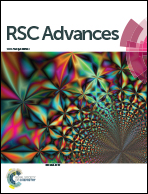Biofixation of a high-concentration of carbon dioxide using a deep-sea bacterium: Sulfurovum lithotrophicum 42BKTT†
Abstract
Concerns about global warming have dramatically increased interest in the development of a strategy for the sustainable and economical fixation of carbon dioxide (CO2). Achieving treatment of high-concentration CO2 (e.g., higher than 1 atm CO2) with a minute thermal energy penalty (e.g., at room temperature) is a significant goal for efficient fixation. Herein, we report the great potential of Sulfurovum lithotrophicum 42BKTT, a deep-sea sulfur-oxidizing bacterium, for the biofixation of CO2 at a pressure as high as 2 atm CO2, mixed with 8 atm N2, at 29 °C. Sulfurovum lithotrophicum 42BKTT exhibited a fast specific fixation rate of approximately 0.42 g CO2 g per cell per h. Moreover, 37% of the total CO2 fixation was present in the form of five dominant metabolites, especially glutamate and pyroglutamate. This work constitutes an efficient biofixation strategy of high-concentration CO2 by using a deep-sea chemolithoautotrophic bacterium.


 Please wait while we load your content...
Please wait while we load your content...